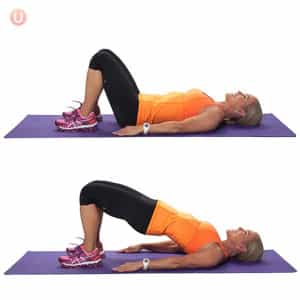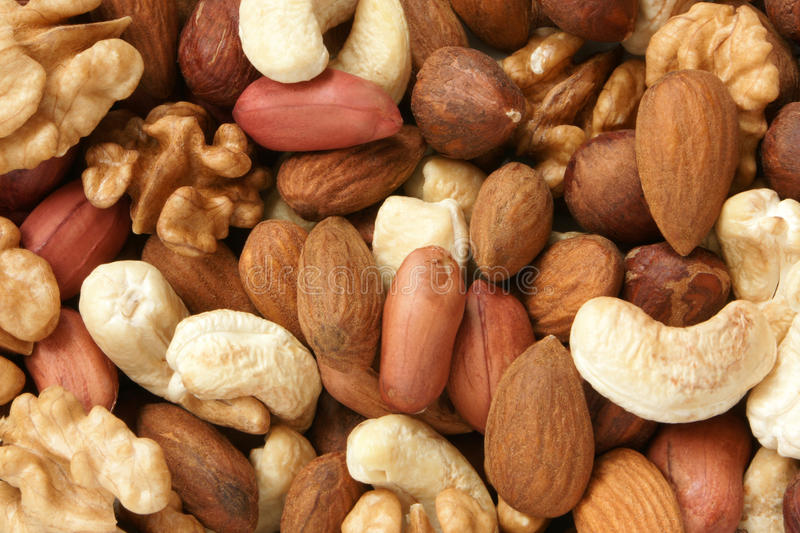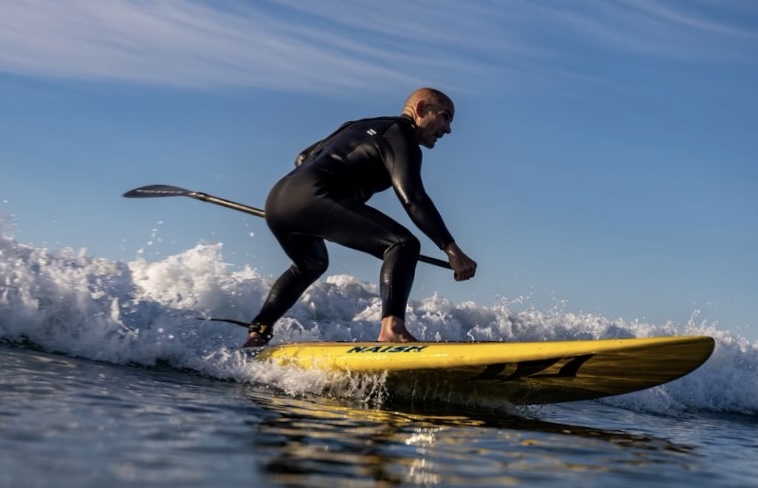If you’ve been reading a certain someone’s highly entertaining and informative articles for the past 18 months, you know that stand up paddling or surfing is great at working your core, back, arms and legs, but (pun intended) it also relies heavily on the gluteal muscles or "glutes". These muscles allow for pelvic stability and movement of the lower leg. If your hips, knees, IT band, or calves are sore or tight after a session, you may need to focus some strength training on your glutes. Strong glutes also assist in keeping our hips strong and loose which is critical for good paddling technique, overall strength and endurance. Great glutes are both functional and practical. They can help you on the dance floor when favorites like “Bootylicious”, “Baby Got Back” and “Shake Your Booty” are being spun by the DJ to keep you dancing far into the night. So - to all you cheeky monkeys - pay attention to these exercises and get ready to build a bombproof backside.

Glute Bridge : Power for Your Backside
The Glute Bridges is essential for increasing strength and muscle endurance in the glutes. In addition to tempo training and isometric holds, the glute bridge can be done against band tension for an added challenge. You can also perform the bridge one leg at a time to seriously ante up your training stimulus. Glute Bridges can improve overall athleticism by strengthening the glutes as well as giving you strength benefits directly related to squats and deadlifts. Those are power moves that benefit any watersport athlete!
How to Do the Glute Bridge Properly:
First, Lie on the floor with your knees bent and your feet firmly planted. Keep your lower back flush against the ground. Then, press your heels into the ground and squeeze your glutes while lifting your hips and lower back off the floor. Continue to contract your glutes and hamstrings until you reach your end range of motion, extending hips as high as you can. Hold for 3 to 5 seconds. Lower slowly with control, reset, and repeat. Start with 3 sets of 12-15 reps and work your way up to 25-30..
Reverse Leg Lift: Stability & Strength for Your Core
The secret to an effective reverse leg lift is to isolate the gluteus muscle during the movement, by using it to push your leg up toward the sky. To begin, lie facedown on a yoga mat or soft surface and support yourself with your arms bent in front of you. Next, using your glute muscle, raise your right leg off of the ground, lifting it as high as you can while keeping your hips square to the ground. Flex your ankle throughout the movement. Return to the starting position with poise and control and repeat using your left leg. You can gradually add resistance by adding either ankle weights or resistance bands, but start with just your bodyweight. Start with 3 sets of 10-12 reps on each leg.
Recovery Strategy: HEAT!
"What’s Happening, Hot Stuff??" – Long Duk Dong, 16 Candles
A few months back, we talked about cold as a recovery tool. Now, we are turning up the temperature and highlighting heat as an equally effective - yet vastly different - tool to help you heal and recover. Heat therapy has emerged as an effective treatment to reduce sore muscles, improve circulation and accelerate healing post workout. NOTE: Always remember that if you are using heat as a recovery tool that hydration and rest are equally important! Don’t bypass those two mainstays for the added benefit of heat therapy. It all works together.
Heat has been hailed in sports science to be an effective treatment to provide relief from soft tissue injuries. Heat therapy works by increasing blood flow and circulation to the treated area which allows for oxidation of the muscles which leads to faster healing times. Heat has also been proven to reduce cellular damage following musculoskeletal injuries and has been revealed to increase mobility following workouts. It also feels great if you’re a cold weather athlete!
However, the term “heat” isn’t very specific. A lot of products claim to have therapeutic temperature benefits but many of them actually get too hot for their primary function to be recovery. When looking for the right product, aim for warm (40-50 degrees), not hot (80-90 degrees). This optimal temperature promotes circulation by dilating the blood vessels to the area where it is applied. It relaxes the area, which can be especially helpful as an aid to delivering additional treatments such as pulse therapy or scraping. When there is less tension in the area, not only are you soothing sore muscles, but you are also relaxing the soft tissue and surrounding muscles so the treatment itself is more enjoyable. Another benefit to warm as opposed to hot heat therapy is you get to practice awareness within your own body and become more in tune with what temperatures feel right to you. This enables athletes to explore other tools or stretches to prevent injury without numbing the area or potentially causing damage to the skin.
A few of the recommended heat therapy tools that are applied topically to the area include hot water bottles, electric heating pads and heated gel pads. Remember, you are going for warm, not blistering temperatures! Limit initial exposure time to 10 minutes and give yourself 20 minutes or so in between sessions before you reapply heat.
A special note about saunas, warm baths and showers - Moist heat therapy can encourage overall feelings of relaxation and wellbeing that may lessen pain. For example, in a hot tub or hot bath, a whirlpool jet aimed at the lower back may offer the additional advantage of a gentle massage. A dry sauna can improve circulation as well as help you sweat out toxins. Whichever method you choose, heat will greatly assist in your post-workout recovery and relaxation! Again, be sure you are adequately hydrating, especially when using saunas!

NUTRITION: Nuts…..Are You Crazy????
In previous articles, I’ve mostly focused on main meal dishes. This month however, our post paddle nutritional focus is a highly nutritious and delicious snack that is as portable as it gets! Pre, post and even mid-session, these tasty morsels satiate your hunger, provide energy and begin the road to nutritional recovery. I’m not talking crazy; I’m talking nuts!
Nuts pack a big nutritional punch in small packages, are easily carried making them an ideal snack for paddle or surf sessions, road trips, hikes and - when you don’t feel like paying $75 dollars for a movie - popcorn. Nuts are a great source of healthy fats as well as a beneficial secondary source of protein. Here are some benefits of a few popular types of nuts.
Almonds: Almonds are rich in Vitamin E, a fat-soluble nutrient that functions as an antioxidant to protect your cells against oxidative damage. This vitamin also supports immune function and cellular communication.
Pistachios: Pistachios are rich in plant compounds like the carotenoids lutein and zeaxanthin, as well as anthocyanins, flavonoids, and proanthocyanidins, all of which have significant antioxidant and anti inflammatory properties
Walnuts: Walnuts have been shown to benefit heart health and may reduce several heart disease risk factors, including elevated blood pressure, LDL (bad) cholesterol, and triglyceride levels. Additionally, human and animal research suggests that eating 1–2 ounces (28–57 grams) of walnuts per day may improve brain function and reduce risk factors for dementia, such as heart disease and Type 2 diabetes
Cashews: Cashews are a good source of several nutrients that are essential to bone health, including protein, Vitamin K, magnesium, and manganese. Several studies have examined whether diets high in cashews improve symptoms of metabolic syndrome, a cluster of symptoms like elevated blood pressure, blood fat levels, blood sugar, and belly fat that increase your risk of heart disease and diabetes.
Brazil Nuts: Brazil nuts are high in a number of vitamins and minerals, including Vitamin E and magnesium, a mineral that’s essential for blood sugar and blood pressure regulation, nerve function, and energy production.
Be sure (unless you or your paddling pals have a nut allergy) to pack some nuts for your next session. Nuts- they’re not just for squirrels!
As always, Stay Strong , Stay Safe and Stay Stoked!
Coach Jeff
Coach Jeff can be reached at runfast728@yahoo.com if you have any questions.









